Hello, and welcome to the SneakyArt Post. This week I share some lines, and some lines about lines.
Podcast Recap
Below are some insights from the last 5 podcast conversations. Visit here for links to the episodes.
In Episode 18, I spoke with Rob Sketcherman (in Hong Kong) about his use of the iPad to make digital paintings on location. He told me about Hong Kong, learning to draw from various resources over the years, and how urban-sketching finally put everything into place for him.
"Nothing has made me open my eyes as much as urban sketching. I think that's one of the greatest gifts we get from doing this." - Rob
In Episode 19, I spoke with Teoh Yi Chie (in Singapore) about the vast audience he has built on YouTube around his art, product reviews, and tutorials. We talk about how he uses diverse media skills to provide regular, engaging content for his subscribers, and his ideas behind growing a successful Patreon account.
"You learn more when you're on location, because you're actually interpreting the scene - working out what to draw or not to draw." - Teoh
In Episode 20, I spoke with Danny Gregory (in Arizona, USA) about the many ways he expresses his creativity, from art and books to his work as a motivational speaker and podcaster. With books like “Shut Your Inner Monkey”, “How to Draw without Talent”, and “Everyday Matters”, Danny has inspired thousands of people to use observational drawing as a way to express themselves.
"Bad doesn't actually mean anything. Bad means mistakes. And mistakes are lessons." - Danny
In Episode 21, I spoke with Alex Hillkurtz (in Paris, France), about making storyboards in Hollywood, and how the city of Paris influences his art today. Alex told me about his discovery of watercolors, and the lessons he takes from his favorite artists, his storyboarding experience, and from painting on location.
"Paris is a fairly monochromatic, muted color palette city. It's easy to draw something in black and white, and add one color. And for me that became red." - Alex
In Episode 22, I spoke with Zainab Tambawalla (in Mumbai, India) about what she learned from her recent sketch-reportage project to share the lives of 6 artisans practicing different trades in the city of Mumbai. We talk about her experience in the Indian animation industry, and how she became an illustrator of children’s books.
"The tool that I was using, i.e. the brush pen, is actually an amazing tool to be on the streets of Mumbai. Because you can stand anywhere and sketch. You don't need to be that person sitting, spreading out, taking out color..." - Zainab
Listen to the SneakyArt Podcast on your choice of streaming service:
Spotify | Apple | PocketCasts | Google | Web | Gaana
Art is for everyone
A recurring theme in all my podcast conversations is that the practice of making art is beneficial to all, regardless of skill level. But for various reasons - some personal, others societal - we have convinced ourselves that it is the privilege of the talented, the prerogative of elites, or the domain of professionals.
A wonderful counter to this self-defeatist attitude comes from Nigerian writer Chinua Achebe, who wrote “Things Fall Apart”, one of the best novels I have read in the last year.
In this BrainPickings article, Maria Popova shares Achebe’s description of the Igbo tradition of mbari, wherein random members of the community are chosen by the goddess Ala to make art in an annual festival of images.
"There is no rigid barrier between makers of culture and its consumers. Art belongs to all and is a “function” of society." - Chinua Achebe
Consider that we do not make art because we are good at making art. We make art because it is good for us.
Natural Frames
I’ve made a couple of trips to Granville Island this week. There are many shops there, and a large indoors public market. Lots of life.
I went with Mike, a fellow artist in Vancouver, and we talked about ‘natural frames’. I look for natural frames wherever I go. Inside them I find art, sneaking about. A natural frame is created by elements of your environment which enclose or frame a slice of the world. On this day, we sat at Blue Parrot Coffee and I saw my view divided into neat boxes.
Each box served as a frame with its own story. Look closely to find the SneakyArt. Notice how the frames neatly separate my scene into foreground, middle-ground and background.
The Old Man and the Screen
At the patio of JJ Beans Coffee, I sipped a flat white and watched cars and buses rumble down the street. Behind me, a lady typed furiously on her laptop. Click clack clickety clack. To my right, a couple on their first date spoke softly in Arabic, stealing nervous glances when they thought the other person wasn’t looking.
The great boon of observational drawing is in the observation itself. You spend time with your subject. You look at things, and then you look again.
My subject of the day was a person in front of me. He was the first thing I drew, because that is how I dive into every blank page - subject first. As I finished with him, as if on cue, he rose to discard his coffee cup, picked up his book, and walked away.
After the drawing, I wrote a little poem for him -
An elderly man at the cafe,
Had a coffee at his table,
And a book as well.
Both stayed untouched,
Both went cold,
As he watched a film on his phone instead.
Big Machines
The engineer in me is fascinated by the sight of heavy machinery. I love watching things work. Assembly lines of any kind always capture my attention. So as I walked back from Opus Art Supplies on Granville Island, I was taken by the sight of this concrete mixing factory.
Framed by the trees and tall bushes, I found SneakyArt in these towering boxes and cylinders and pipes and chutes. Tiny humans walked about, talking into walkie-talkies, driving in and out on trucks. Things were going on.
Tiny People
My sketchbook of tiny people continues. I found many tiny people on Granville Island from my perch beside the bicycle parking lot.
There is a philosophy to drawing tiny people, akin to phenomenology. I strip away the layers of obfuscation and distill every person to their essential lines. I remove all that separates them from me, and leave only the things we universally recognize. The art of tiny people brings us to “the things themselves”, as I explain in this post.
Next Week!
Next week we complete one year with this newsletter. Big thanks to everyone who has been with me on this journey. The SneakyArt Post started out of sheer audacity and nerve, and I will continue on this theme with an announcement about some exciting, new plans!
As always, thank you for your time and attention.






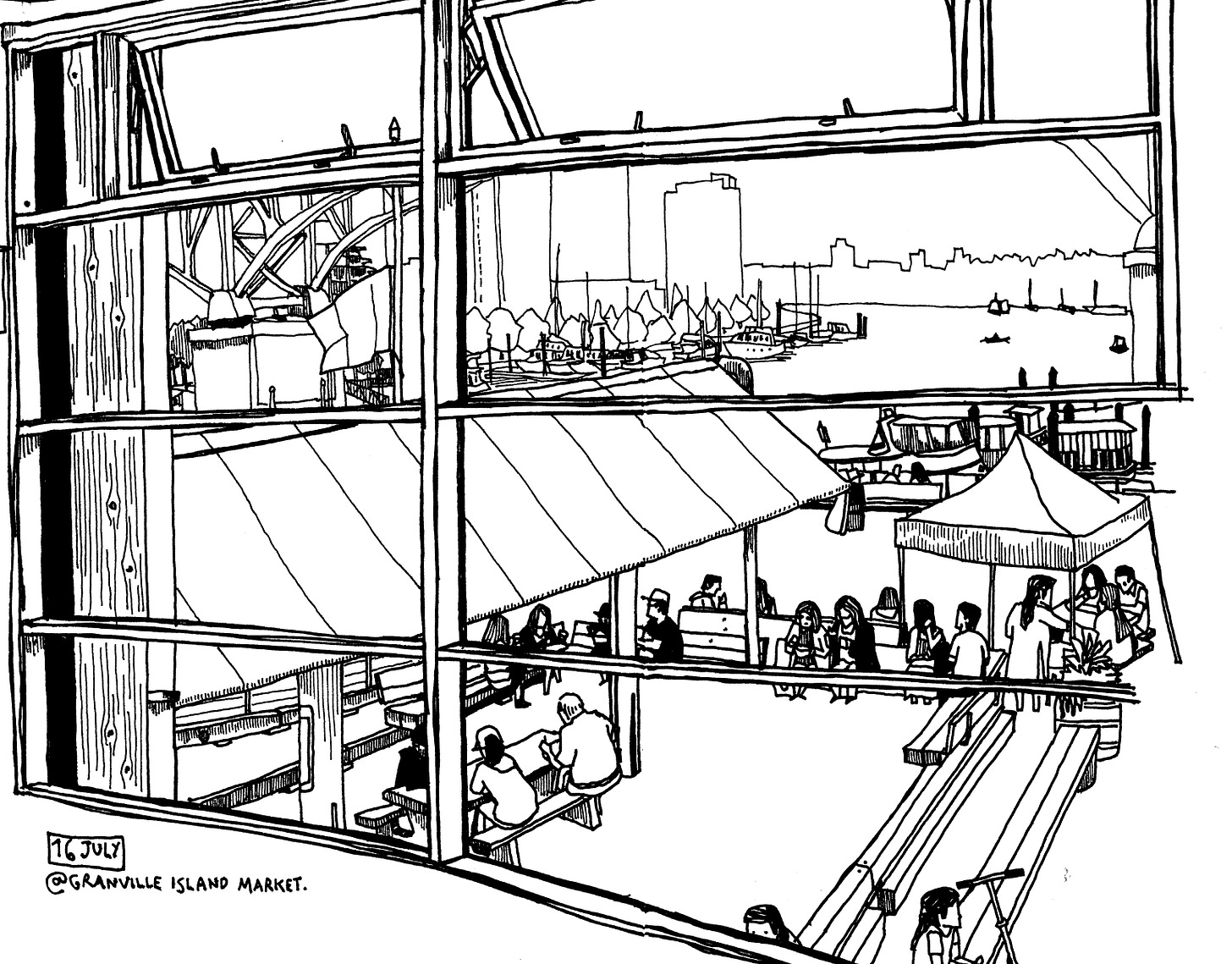
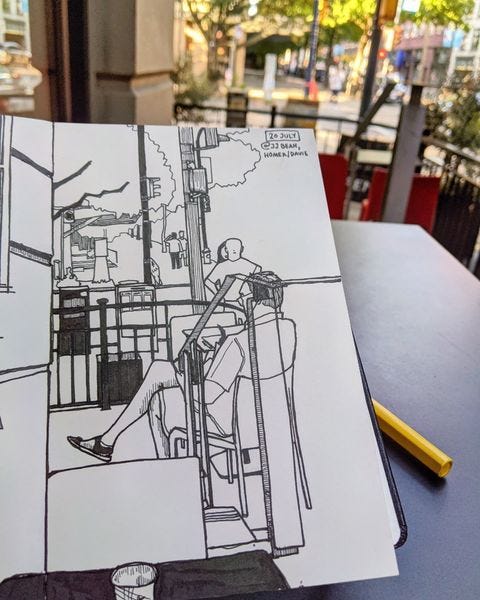
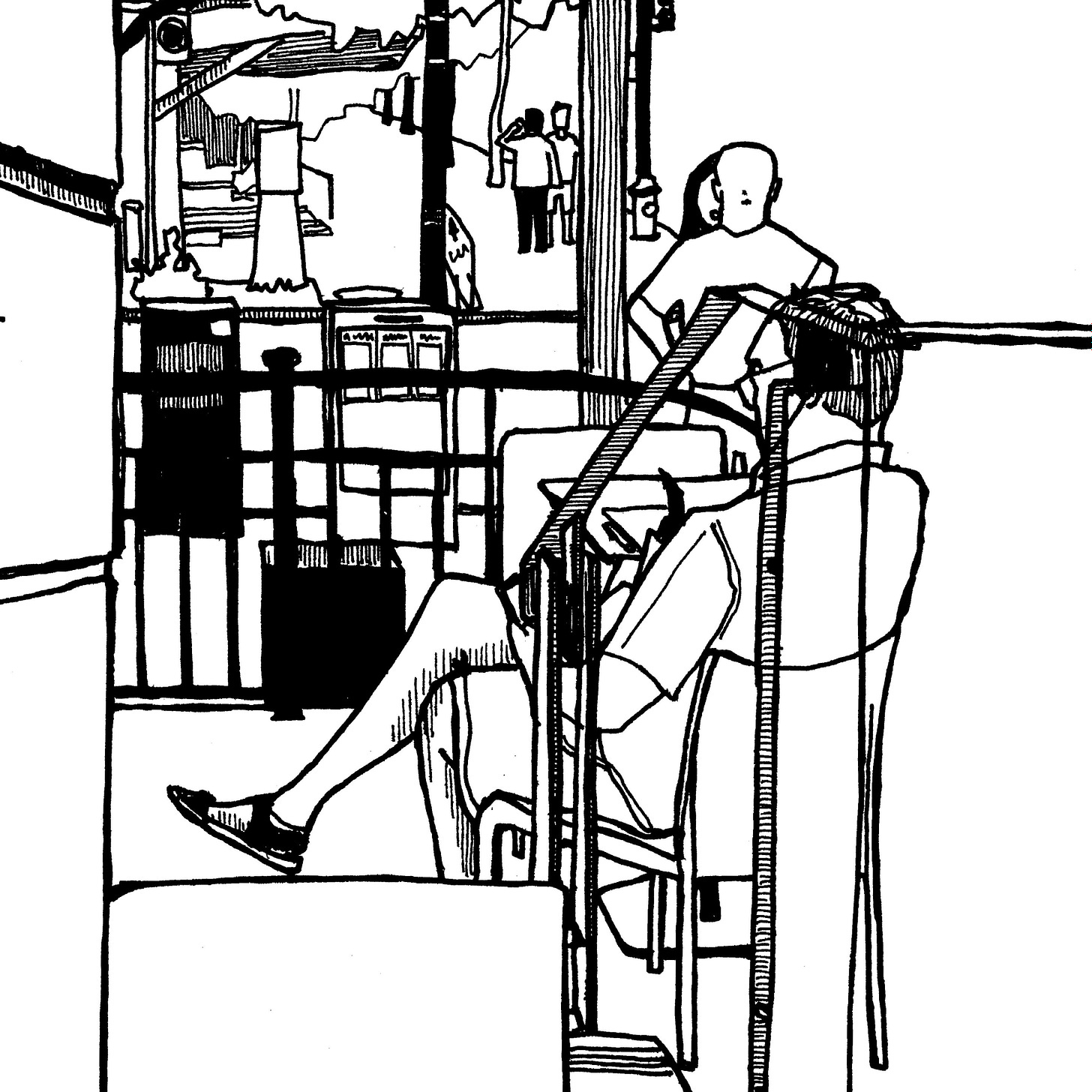
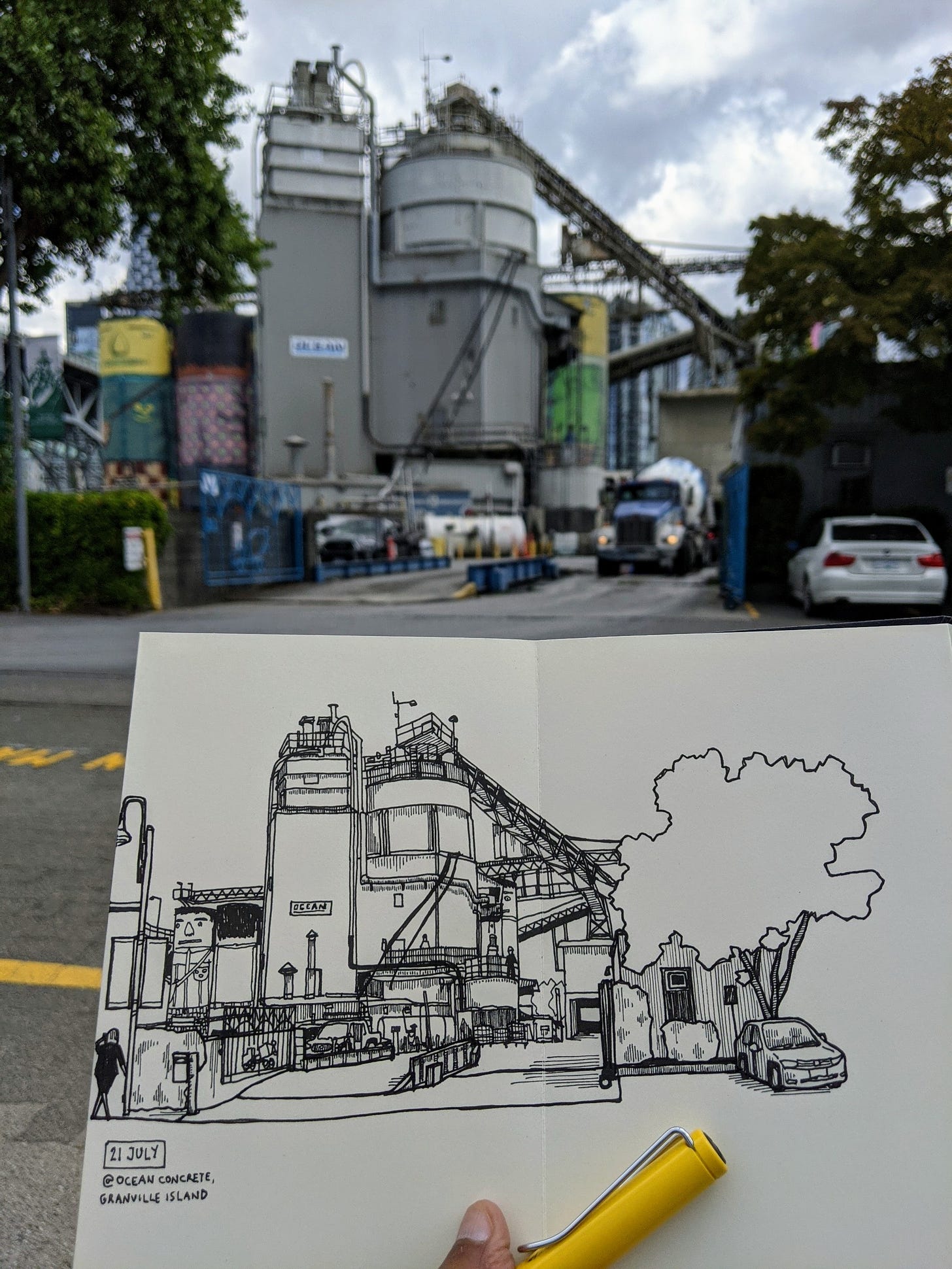
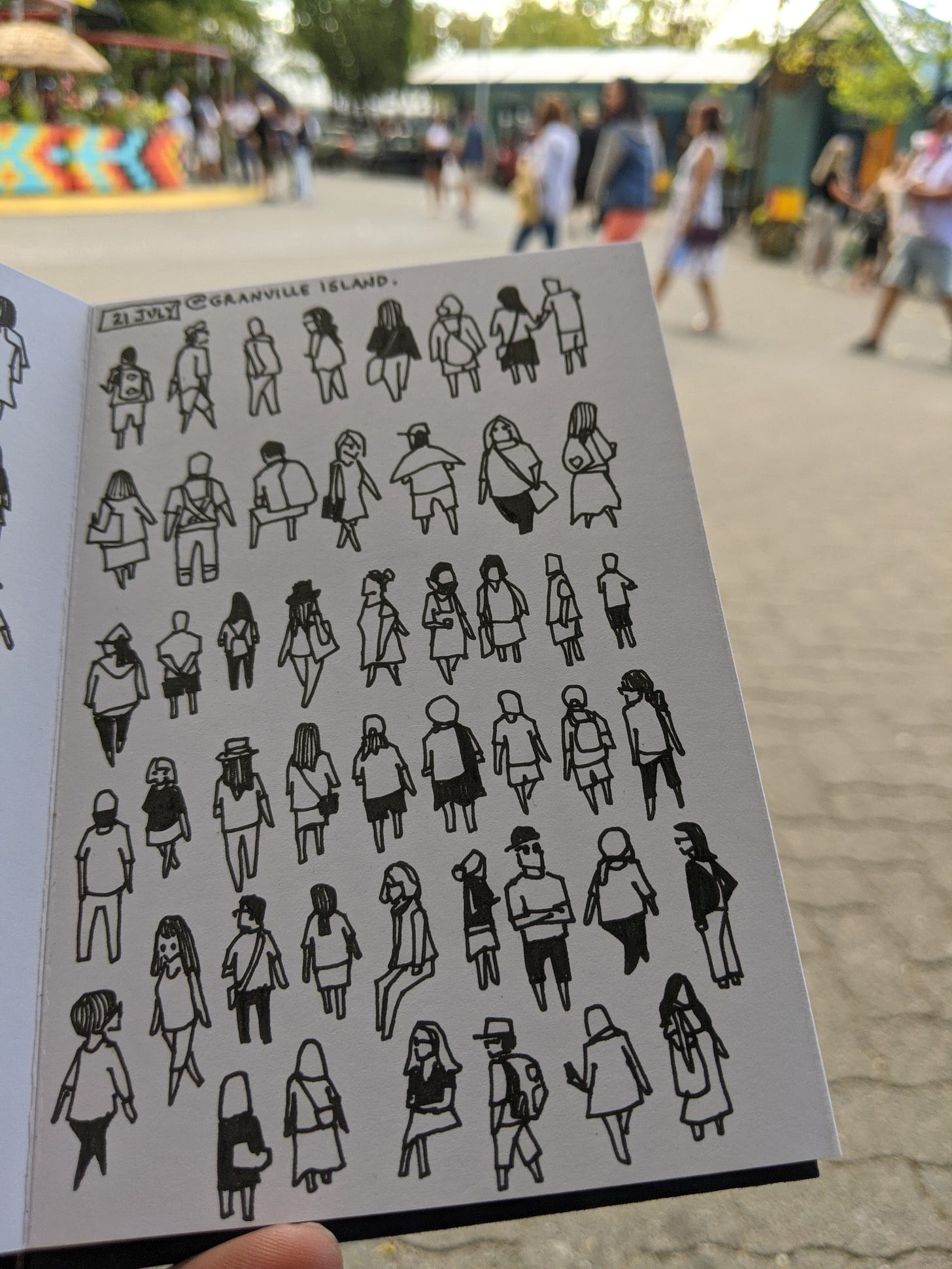
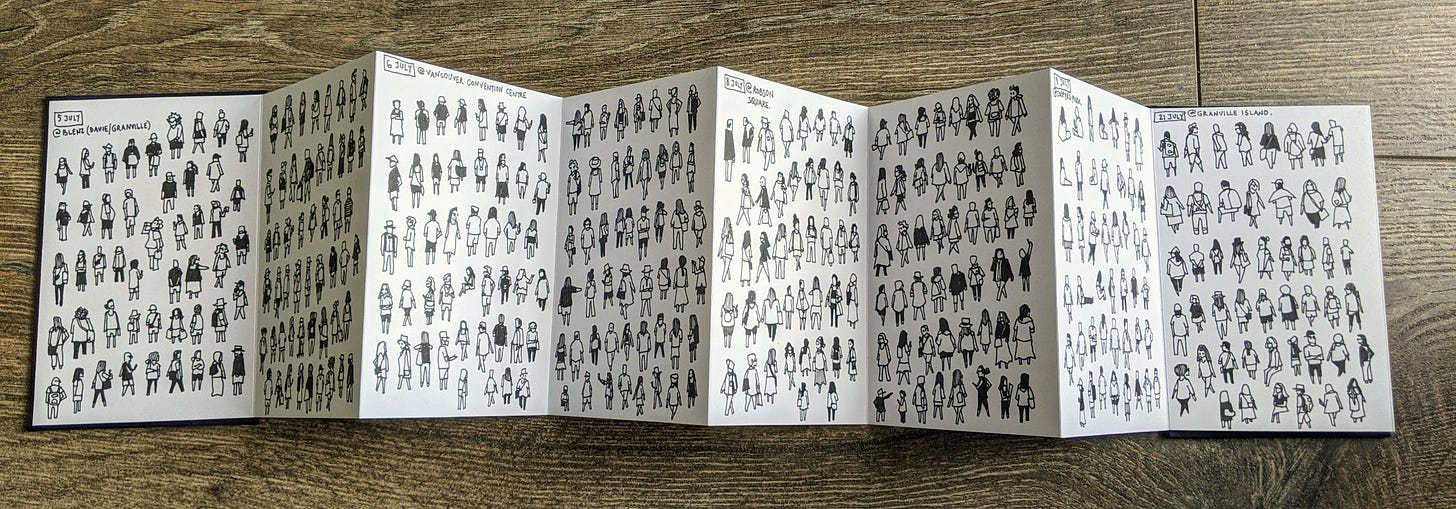
Really good newsletter Nishant. I always look forward to see what the sneaky artist is up to. You never let me down!